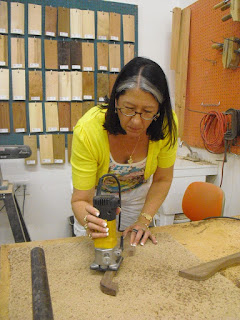Can I go off a bit about staining wood?
When my customers request something made in darker wood tones, I usually suggest that we use dark wood from the start. Staining lighter woods can be a huge challenge, both in the way in which wood accepts color, and later in the process, when wood can be damaged.
If we start with darker woods, it's easier to apply a clear finish, like Danish Oil. In fact, that's why we use clear Danish Oil on just about everything that we build in my shop.
I've seen more projects ruined by a poor finish than just about any other problem out there.
Someone can build a perfect piece - with excellent design and proportion, perfect joinery, excellent sanding.... but if a bad finish is applied, the overall impression of the piece is often ruined.
So... staining is my pet peeve.
Now, don't get me wrong - I stain a fair amount of work, but a huge complaint is that when wood that is stained gets dinged or chipped, the resulting blemish exposes the lighter wood underneath, and it looks horrible.
Either way, it's a lose/lose situation.
I recently built a giant thermometer for a church - you know those thermometers that keep track of fund raising efforts?
Sure, you can buy a wall poster to hang up, and keep track of your progress that way. But this church wanted one that they could use over and over, and commissioned me to design a nice one.
To keep some costs down, we decided upon a stained outer frame. Over the course of building it, I had to stain the wood, which caused the grain to raise a bit. I usually use a soft sanding block with 400 grit sandpaper on it, to knock down the roughness, but when I did that, I accidentally exposed some of the lighter wood underneath.
(On darker woods, that wouldn't have occurred.)
It's really hard to touch up those areas, because you don't have a ton of control where the stain flows.
It's easy to darken the surrounding areas when you're trying to just touch up the lighter ones. You can chase your tail all afternoon doing this!... trust me, I've been there.
Then I found a game-changer.
I stopped by my local Mohawk dealer, to pick up some finishing supplies and asked if they had any suggestions for touching up small stain defects, and lo-and-behold, they led me to this...
Who knew?! These sticks are nothing short of a lifesaver to me, and I can't believe I had never heard of them before. In fact, I bought a variety of them to keep in stock, for future problems.
It's nice to have a few tricks up your sleeve when problems arise in the woodshop!



















































